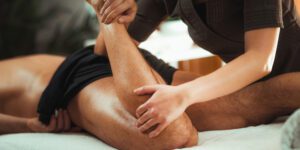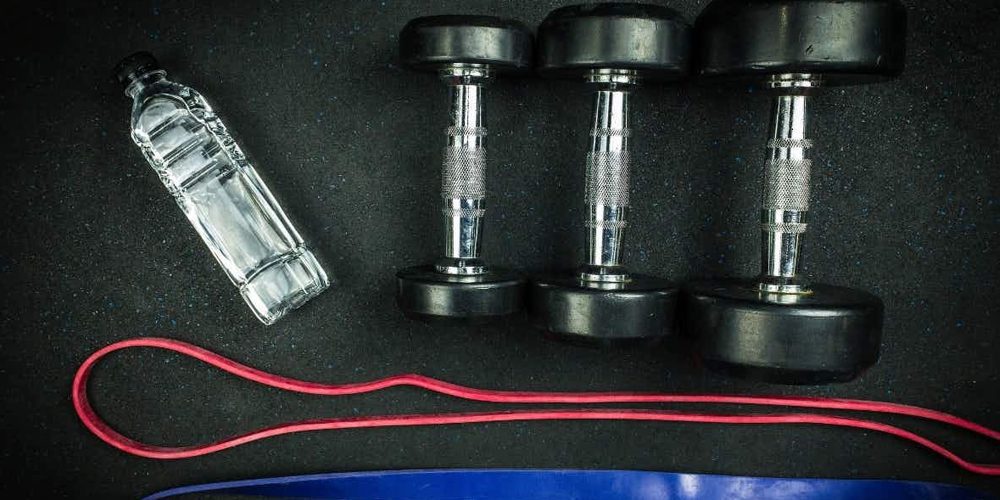Achilles tendinitis is an overuse injury of the Achilles tendon. The Achilles tendon connects calf muscles at the back of the lower leg to your heel bone. This condition can be caused by sudden increases in intensity or duration for runners, or middle-aged people who play sports only on weekends. It is a relatively simple condition to treat and can be done at home under supervision by a doctor. Treatment options for this common injury include rest, compression, ice application and physical therapy exercises.
The Achilles tendon is what connects your heel bone to the calf muscles. It helps power the upswing as you walk or run, as it contracts to bring your heel up toward your calf. When you have Achilles tendinitis, the tendon becomes irritated and inflamed due to overuse during exercise. But only in rare cases Achilles tendinitis can lead to ruptures that call for surgical repair.

What are the symptoms of Achilles tendinitis?
Achilles tendinitis affects athletes when they suddenly increase intensity or duration of exercise. Symptoms include a dull or sharp pain in the back bottom area of the lower leg that gets worse with running, walking and jumping activities. This can be accompanied by stiffness and weakness in your calf muscles due to limited motion at the ankle joint. Most cases have mild symptoms that go away with rest, ice and compression to the affected area.
Risk factors that favor Achilles tendinitis
- Your gender. 84% of Achilles tendon problems occur in men according to the NIH’s National Institute of Arthritis and Musculoskeletal and Skin Diseases (NIAMS)
- Your Age. One in every 3 people older than 50 years report an Achilles tendon injury
- Your body weight. People with higher weights are more at risk, especially if you’re overweight
- Medical conditions. If you have diabetes or high blood pressure, these can also put you at risk
- Bad equipment. You wear shoes that don’t fit properly or wear shoes for extended periods of time without taking short breaks which can lead to overuse conditions
- Physical conditions. Tight calf muscles or naturally flat arches can put more strain on the Achilles tendon and cause problems
- Medications. If you need to take antibiotics, the risk of Achilles tendinitis may occur at higher rates
Diagnosing Achilles Tendinitis
Your doctor can diagnose Achilles tendinitis by examining your lower leg. He may ask you how the pain started, whether it is constant or intermittent, sharp or dull and how long it lasts after activities. You might have imaging studies such as an MRI scan to check if there are other injuries in your calf muscles or ankle bones.
The doctor checks the affected areas to pinpoint where the pain and swelling occur and may ask you to do certain exercises, such as standing on the balls of your feet to better observe your range of motion and flexibility.
What is the best treatment for a sore Achilles tendon?
Self-care treatment options for this condition include resting, applying ice to the affected area, staying off your feet for a few days by using crutches or braces, and wearing shoes with arch support.
Your doctor might recommend nonsteroidal anti-inflammatory drugs (NSAIDs) such as ibuprofen to reduce inflammation. The Anti-inflammatory injection into the sore tendon might also help treat this condition.
Other treatment options to speed up recovery include staying hydrated, wearing high-quality shoes and using prescription shoe inserts. Exercise therapy is managed by physical therapists or athletic trainers who can show you different types of stretching exercises for your hips, calf muscles, and Achilles tendon. You may have to wear a cast or brace on your ankle for six weeks.
If you have Achilles tendinitis, it’s important not to start running again until you are completely pain-free. You may be given an activity plan that describes when and how much you can exercise based on how far along you are in the healing process. Your doctor also may recommend orthotic shoes as a long-term solution to reduce this problem. If you have excessive pain or your tendon ruptures, surgery may be the only option.
However, despite all these treatments and preventive measures Achilles tendinitis can recur if you don’t give your tendon enough time to heal. The first month is crucial for re-injury and attempting to run before the pain has subsided can be disastrous.
Even those who exercise regularly are at risk of suffering from Achilles tendinitis. The best treatment for this condition is taking it slow and preventing small injuries from becoming big problems.
Is it OK to walk with Achilles tendinitis?
Achilles tendinitis usually heals within a few weeks, but self-care activities such as walking can be done safely to speed up the healing process. One study found that walking regularly even with the help of crutches was safe and didn’t worsen knee pain issues in people with Achilles tendinitis. But wearing proper shoes is important to avoid re-injury.
How long should you rest Achilles tendinitis?
Most forms of Achilles tendinitis are treated with rest, ice, compression and elevation. But how long you need to stay off your feet depends on the severity of the condition. Most people recover within a few days or weeks, but in rare cases it can take several months or longer before symptoms fully disappear.

It is also possible that Achilles tendinitis can recur even after you’ve been treating this condition for several months. In such cases, your doctor may recommend wearing shoes with custom-made inserts to correct your biomechanical issues and prevent future injuries.
Prevention techniques
Here are some tips to help you prevent this condition.
Use the proper type of running shoes that fit well and don’t cause irritation or injury on your feet, ankles or lower legs. Ensure that these shoes have appropriate cushioning, stability and shock absorption for your foot type. Replace them frequently as recommended by manufacturers.
Invest in good-quality running socks that don’t cause any irritation or foot blisters. In case you suffer from runners’ toe, avoid wearing the same pair of shoes daily to prevent fungal infections and athlete’s foot.
Warm up for 5-10 minutes before a run by walking around or doing some stretching exercises to get your blood flowing to your muscles. Also make sure you warm down properly after a run by walking or doing some exercises for 5-10 minutes.
Ensure that you vary your running workouts with speed training, hill runs and long distance runs to avoid fatigue. Varying your workout routine also helps prevent injuries by strengthening different muscle groups in the legs.
Always remember that a sudden increase in running intensity or duration can lead to Achilles tendinitis. Don’t keep your body under too much stress by increasing your workout regimen suddenly and give it time to rest and recover between intense workouts.
Practice good hygiene by keeping yourself clean from the inside out, eating a balanced diet with healthy proteins, carbohydrates and fats. Also ensure that you drink plenty of water to keep your body hydrated and joints supple.
If you have a sedentary job, try taking a short walk break every hour to help your leg muscles relax from constant sitting. This also prevents blood from pooling in your lower limbs which can reduce the risk of developing this condition.
These are a few simple steps that can help you prevent Achilles tendinitis. The first month is crucial for this condition, so take the right measures to treat and prevent it.
What is the fastest way to heal Achilles tendinitis?
We mentioned it earlier, the best and fastest way to heal and get rid of Achilles tendinitis is called the RICE method. RICE stands for Rest, Ice, Compression and Elevation.
Here is how you execute the RICE method:
Rest your leg for one or two days. You can still go to work and do daily activities, just try not to run or jog. Resting means no motion, so if it hurts too much, stay home instead of hobbling around at work.
Ice your Achilles tendon for 15-20 minutes every hour or two for the first couple of days. This helps reduce pain and swelling.
Wrap a bag of ice in a thin towel, and apply it directly to your Achilles tendon. Make sure you don’t apply the ice directly to your skin as this may cause frostbite.
Compress your Achilles tendon with a bandage, specific socks or athletic tape to reduce swelling.
Elevate your foot above the level of your heart to reduce fluid pressure on the tendon and improve blood flow. You can do this by resting it on a pillow while you sleep, or sit with your leg propped up so that your foot is higher than your heart.
We know this method may sound simple, but it’s the most effective way to heal and get rid of Achilles tendinitis as fast as possible. However, if you don’t like the idea of using ice every hour or two, we understand. Doctors often recommend skipping icing and instead massaging your tendon to help break up scar tissue and increase blood flow to the connective tissue. Also, a heating pad is a great way to reduce pain and can be used in place of ice.
Do compression socks help with Achilles tendinitis?
We highly recommend wearing compression socks when you use the RICE method. This is crucial in order to properly relieve the pain because it prevents any swelling in your feet and legs.
The pressure of the socks helps nourish your body with blood, oxygen and nutrients which are vital for recovering from this condition faster. Compression socks also help reduce recovery time after exercise, which is crucial for preventing Achilles tendinitis.
What are the best shoes for this condition?
Doctors typically recommend wearing supportive, cushioned running shoes with a low or no heel drop to provide enough arch support for your feet. Wearing proper footwear can help prevent Achilles tendonitis because it protects your feet from injury and helps your leg muscles recover properly after exercise.
Try to fit into footwear that are at least half a size too small because this will help reduce the risk of injury. Also, try not to wear your shoes all day long as it can put lots of pressure on your feet and cause strain. At night take off your shoes completely and rest your feet bare to avoid any strain and keep your muscles from getting stiff.
There are a few other products that can help with this condition. You should definitely try out a heel lift or heel cup which will provide extra cushioning for your Achilles tendon and reduce pressure on the tender area. Also you can use calf sleeves to protect your calves from injuries during exercise as well as speed up the recovery process.
These products provide adequate support for your feet and can help you prevent Achilles tendinitis in the future.
If you’re struggling with Achilles tendonitis, the RICE method is a great way to heal and get rid of this condition. In order to properly treat it, we recommend wearing compression socks when using the ice treatment. You should also invest in supportive running shoes that have low or no heel drop for your feet so they can recover better after exercise. For more information check out our store for appropriate products and little helpers. We would love to hear from your. So please share your story, tips and experiences with Achilles tendinitis or other sorts of foot pain.





















